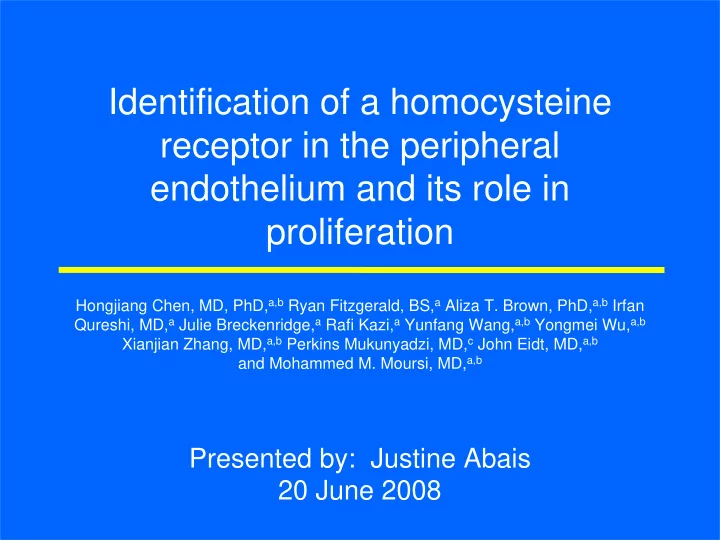

Identification of a homocysteine receptor in the peripheral endothelium and its role in proliferation Hongjiang Chen, MD, PhD, a,b Ryan Fitzgerald, BS, a Aliza T. Brown, PhD, a,b Irfan Qureshi, MD, a Julie Breckenridge, a Rafi Kazi, a Yunfang Wang, a,b Yongmei Wu, a,b Xianjian Zhang, MD, a,b Perkins Mukunyadzi, MD, c John Eidt, MD, a,b and Mohammed M. Moursi, MD, a,b Presented by: Justine Abais 20 June 2008
Background • Increases in homocysteine produce proportionate increases in intimal hyperplasia • Role of the N-methyl-D-aspartate receptor (NMDAr) and its affinity for homocysteine • Objectives of this study: 1. Detect the expression of NMDAr in both rat carotid artery tissue and rat aortic endothelial cells (RAEC) 2. Determine whether homocysteine affects the endothelium in terms of cellular replication – Noncompetitive antagonist MK801 � Hypothesis NMDAr exists in the vascular endothelium and homocysteine works through this receptor to initiate cellular proliferation at the endothelial level.
Methods • Immunohistochemistry • Cell culture and treatment • Western Blot • Reverse Transcription PCR • Cellular replication and proliferation – 3 H-thymidine
Results Immunodetection Fig 1. Immunodetection of NMDAr NR1 subunits in rat carotid artery and brain. Rat brain and carotid artery from previously endarterectomized rats were analyzed for the NR1 NMDAr subunits. Right panel figures are negative controls, left panel figures are positive for NR1 antibody and used to immunolocalize NMDAr subunits, rat carotids, rat carotids were photographed at 200 magnification. Positive-bound complexes are indicated by increasing intensity of color. Rat brain sections were used for positive controls and were photographed at 400 magnification.
Results NMDAr expression through RT-PCR Fig 2. Expression of NMDAr subunits in RAECs. Positive identification of NMDAr subunits was confirmed in RAECs by RTPCR. NMDA receptor subunit sizes are given by base pair (bp) (NR1 333, NR2A 224, NR2B 222, NR2C 204, and NR2D 224 bp). An analysis of the receptor subunit bands indicated 99% to 100% identification sequence homology to NMDAr cDNA subunits in GenBank, shown in Table II.
Results Western Blot Fig 3. Homocysteine (Hcys) stimulation of the protein expression for the NR1 NMDAr in RAEC over time (A) and by dose (B). Results are representative of three separate experiments. A, Homocysteine- treated endothelial cells (50 M) increased protein (size, 130 kD) concentrations of the NMDAr. Three to 12 hours of treatment indicated increased protein levels compared with controls or zero time. Six hours of treatment provided the highest increase in NR1 protein. The housekeeping gene -actin was used as a loading control (size, 42 kD). B, Increasing concentrations of homocysteine increased endothelial cellular NR1 subunit protein after 6 hours of treatment. Homocysteine treatment at 50 M produced the highest concentration of NMDAr protein (130 kD) as indicated by Western blot analysis. The housekeeping gene -actin was used as a loading control (size, 42 kD).
Results Cellular replication by 3 H-thymidine Fig 4. Increases in homocysteine 3H-thymidine incorporation are attenuated by MK-801. Cultured RAECs were treated with either control (CON), CON 50 M of MK-801, 50 M homocysteine (HCYS), or HCYS 50 M of MK- 801 for 48 hours. Homocysteine treatment of the endothelial cells increased 3H-thymidine incorporation vs all groups, which was attenuated with the addition of 50 M of MK-801 to the homocysteinesupplemented cells for a decreased rate of cellular replication. N 6/treatment group. Means are SEM. * P value of .001 vs other treatment groups.
Results Cellular proliferation Fig 5. Proliferative effects of homocysteine on aortic endothelial cells. RAECs were cultured and treated with increasing concentrations of homocysteine. A 50-M homocysteine group was cotreated with MK-801 (50 M), which blocked cellular proliferation when compared with 50 M homocysteine only. All groups had an N 6/treatment. * P value of .05 vs control or homocysteine 50-M MK-801–treated cells.
Discussion • NMDAr was identified in the endothelium • Homocysteine elicits a proliferative response in peripheral vasculature through direct interaction with the NMDAr – Upregulated NR1 expression and increased cell proliferation • NMDAr may serve as a useful point of intervention in the prevention of pathological effects attributed to elevated levels of homocysteine � NMDAr exists in the endothelium and homocysteine may utilize this receptor to induce intimal hyperplasia.
Questions?
Recommend
More recommend